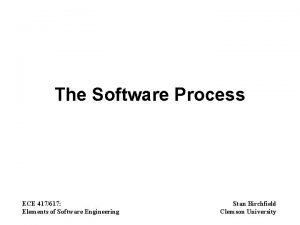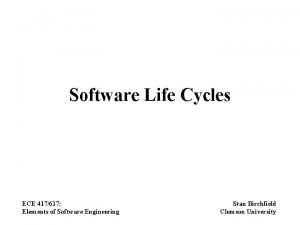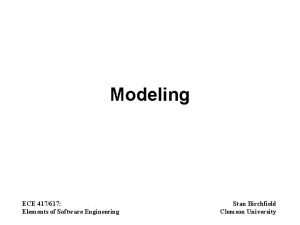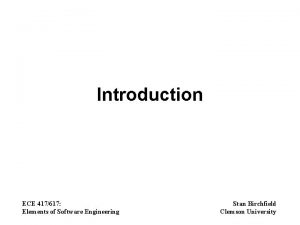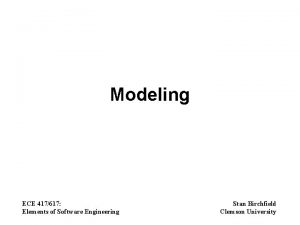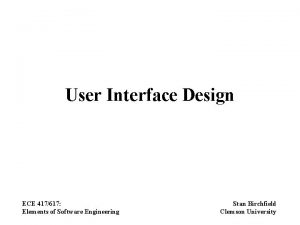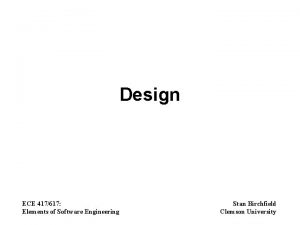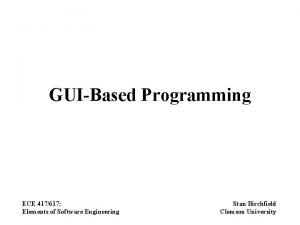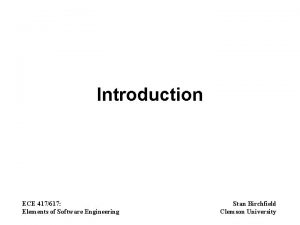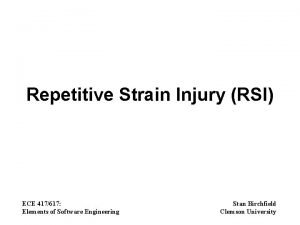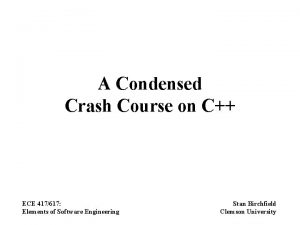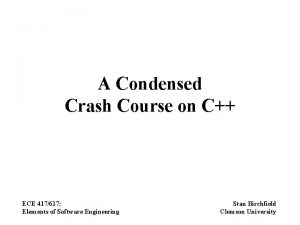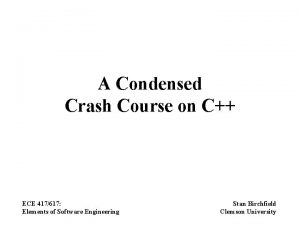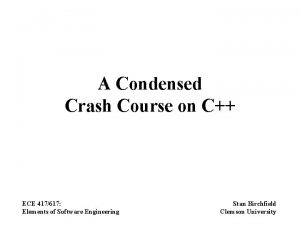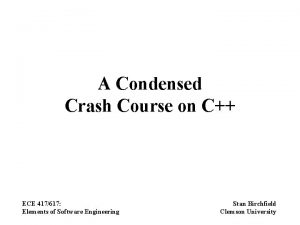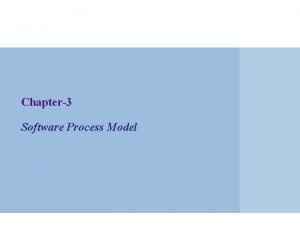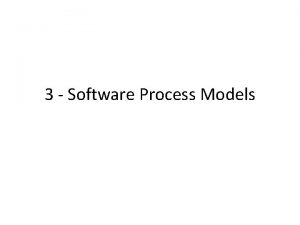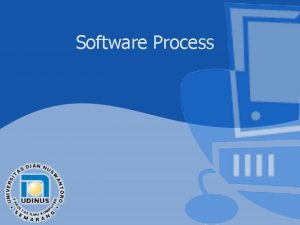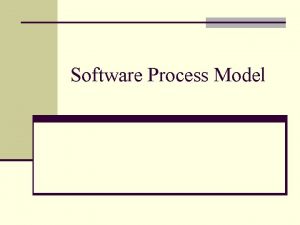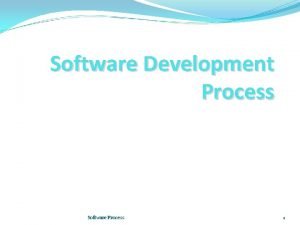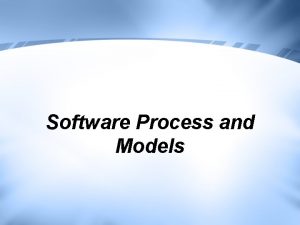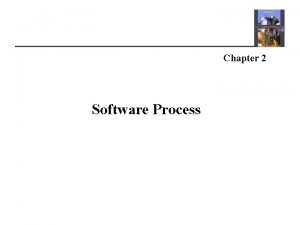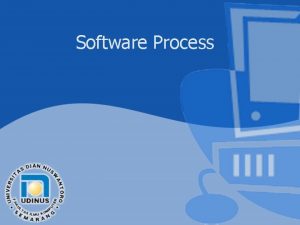The Software Process ECE 417617 Elements of Software








![Shark tooth model [from Michael Black] Shark tooth model [from Michael Black]](https://slidetodoc.com/presentation_image_h2/1a52b1d58f9dd296106f15eae6ff8aa5/image-9.jpg)



















- Slides: 28

The Software Process ECE 417/617: Elements of Software Engineering Stan Birchfield Clemson University

Life cycle phases 5 phases of every S/W life cycle: 1. 2. 3. 4. 5. Communication – requirements gathering, project initiation Planning – determine tasks, risks, resources, work products, schedule; estimate, schedule, track Modeling – create models to facilitate more precise communication and planning; includes analysis and design Construction – code generation and testing Deployment – delivery, feedback, support Two approaches: prescriptive and agile

Waterfall model Requirements Analysis System Design Object Design Coding Testing Installation [adapted from Royce (1970)] Maintenance

What is wrong with waterfall? Requirements Analysis Maintenance System Design Installation Object Design Testing Coding Interrelated nonlinear, sequential

less detail V-model Requirements Analysis Acceptance Testing is validated by System Design System Testing more detail Object Design Unit Testing Coding build system validate system

features Incremental model increment #3 A D C T M version #2 increment #2 A D increment #1 A D C T M version #3 version #1 time

Rapid application development (RAD) Team #1 Communication Modeling Construction Planning Team #N Modeling Construction Developed by James Martin at IBM in 1980 s 60 – 90 days RAD has largely been discredited because it has not proved successful "RAD is back", says IBM, Information Age, Feb. 10, 2006 http: //www. information-age. com/articles/296861/rad-is-back-says-ibm. thtml Deployment

Prototyping Communication Feedback Quick plan Delivery Quick modeling Construct Prototype • Enables faster feedback • Can be incorporated into other models • But what is the danger?
![Shark tooth model from Michael Black Shark tooth model [from Michael Black]](https://slidetodoc.com/presentation_image_h2/1a52b1d58f9dd296106f15eae6ff8aa5/image-9.jpg)
Shark tooth model [from Michael Black]

Spiral model Deployment Communication start Construction Planning Modeling “Risk-driven approach” [developed by Barry Boehm, 1988]

Concurrent Each activity can be in a different state: none under development awaiting changes under review under revision done baselined

Unified process software increment Communication inception Planning Deployment elaboration transition Construction Modeling construction • • Incremental, iterative “Unified” same originators as UML Also called Rational Unified Process (RUP) Based on spiral model, developed at Rational Software, a division of IBM since 2003

Unified process work products Inception phase vision document initial use-case model initial business case initial risk list project plan prototype(s). . . Elaboration phase use-case model requirements analysis model preliminary model revised risk list preliminary manual. . . Construction phase design model SW components test plan test procedure test cases user manual installation manual. . . Transition phase SW increment beta test reports user feedback. . .

Agile development • S/W development is unpredictable – requirements will change (which ones? ) – design and construction are interleaved (how much design is needed? ) – analysis and testing, too • Solution: Use an adaptable process – incremental development strategy

Agile principles • Agile Manifesto (2001) values – – • individuals and interactions over processes and tools working software over comprehensive documentation customer collaboration over contract negotiation responding to change over following a plan Agile principles: – – – – satisfy customer (highest priority) early and frequent S/W delivery welcome changing requirements work daily with business people and developers build projects around motivated individuals simplicity: maximize the amount of work NOT done self-organizing teams regular reflection to adjust behavior to improve effectiveness

Extreme programming (XP) Kent Beck became project leader of Chrysler’s payroll project in 1996 Project canceled in 2000 [Kent Beck, Extreme Programming Explained, 1999] [from extremeprogramming. org]

A simpler view of XP CRC cards design planning spike solutions (prototypes) coding refactoring test S/W increment unit test acceptance test continuous integration

XP principles 1. 2. 3. 4. 5. 6. 7. 8. 9. 10. 11. 12. Test-driven development The planning game On-site customer Pair programming Continuous integration Refactoring Small releases Simple design System metaphor Collective code ownership Coding standards 40 -hour work week Pros and cons?

Adaptive S/W development (ASD) • ASD focuses on human collaboration and team self-organization collaboration speculation learning S/W increment [Highsmith 2000]

Scrum • Backlog – prioritized list of project requirements or features • Sprints – work units required to achieve a requirement – deliver within fixed time (30 days) – no changes to requirement allowed during that time • Daily meetings (15 min. ) – What did you do? – What obstacles are you encountering? – What is your plan? • Demos – S/W increments delivered to customer (can ship final product upon demand)

BDUF controversy • BDUF – Big design up front • Proponents claim that planning up front saves lots of time in the end • Much faster to fix a bug in the spec than in the code • An ounce of prevention is worth a pound of cure • Who is right? Both. Strive for balance.

Model summary Prescriptive models • Waterfall • Incremental • RAD • Spiral • Concurrent development • Component-based development • Formal methods • Aspect oriented • Unified process (RUP) Agile models • Extreme programming (XP) • Adaptive software development (ASD) • Dynamic systems development (DSDM) • Scrum • Crystal • Feature driven development (FDD) • Agile model

Synch-and-stabilize • How to balance structure and flexibility? • Solution: – Plan product with vision statement – Translate into specification document with enough detail to divide the work – Divide into parts and assign to teams – Teams are free to implement, innovate as they wish – Teams work under common environment – Teams check-in work frequently – Frequent (daily) builds – Always a working system – Easy to test, see defects, measure progress continually [from “How Microsoft Builds Software”, Cusumano and Selby]

Personal software process (PSP) • Individual developers should – – measure the quality of output plan (estimate and schedule work) identify likely and actual errors use metrics to improve process • Activities: (1) planning, (2) high-level design, (3) high-level design review, (4) development, (5) postmortem • Disciplined metrics-based approach to software engineering • Requires significant training • Improves productivity and quality, but resisted by many developers (culture shock) [SEI’s Watts Humphreys]

Team software process (TSP) • Project team should – be self-directed, able to plan and track their work, establish goals, and own their processes and plans – have consistent understanding of its overall goals and objectives – define roles and responsibilities – track quantitative project data – identify and implement an appropriate process for the project – define local standards – continually assess and respond to risks – track, manage, and report project status • • Activities: (1) launch, (2) high-level design, (3) implementation, (4) integration and test, (5) postmortem Rigorous approach that requires a full commitment from the team Requires thorough training Improves productivity and quality [SEI’s Watts Humphreys]

Formal inspections • • • Developed by Michael Fagan at IBM, 1970 s and 1980 s More effective than informal “walk-throughs” Participants: – Designer/Author – responsible for producing program design – Coder/Reader – paraphrases the design/code as if they will implement it – Tester – views product from testing standpoint – Moderator – acts as “coach”; goal should be to invite “Phantom Inspector”, the additional presence that seems to materialize from the synergy of the group • • If the coder and designer are the same person, then someone else fills the roll of coder Example inspection result: In module X, line Y: check is performed one less time than required – LO/W/MAJ (logic error, wrong, major) Maximum inspection rate: 125 Noncommentary source statements (NCSS) per hour (for systems programming) An inspection session should not exceed two hours to avoid diminishing ability to concentrate

Inspection process Each step is essential: 1. Overview – educate participants, assign roles 2. Preparation – participants prepare for roles 3. Inspection – find defects (do not find solutions) 4. Rework – author fixes all defects 5. Follow-Up – verification by moderator or team to ensure that no secondary defects have been introduced (approximately 1 in 6 fixes are wrong)

Types of inspections • IT 1: finds voids and discrepancies in test plan • IT 2: finds errors in test cases • I 0: inspects internal specifications • I 1: inspects design complete spec • I 2: inspects code Note: It is 10 to 100 times less expensive to find/correct errors early in the process
 Hình ảnh bộ gõ cơ thể búng tay
Hình ảnh bộ gõ cơ thể búng tay Ng-html
Ng-html Bổ thể
Bổ thể Tỉ lệ cơ thể trẻ em
Tỉ lệ cơ thể trẻ em Gấu đi như thế nào
Gấu đi như thế nào Thang điểm glasgow
Thang điểm glasgow Alleluia hat len nguoi oi
Alleluia hat len nguoi oi Môn thể thao bắt đầu bằng từ chạy
Môn thể thao bắt đầu bằng từ chạy Thế nào là hệ số cao nhất
Thế nào là hệ số cao nhất Các châu lục và đại dương trên thế giới
Các châu lục và đại dương trên thế giới Công thức tính thế năng
Công thức tính thế năng Trời xanh đây là của chúng ta thể thơ
Trời xanh đây là của chúng ta thể thơ Mật thư tọa độ 5x5
Mật thư tọa độ 5x5 Phép trừ bù
Phép trừ bù độ dài liên kết
độ dài liên kết Các châu lục và đại dương trên thế giới
Các châu lục và đại dương trên thế giới Thơ thất ngôn tứ tuyệt đường luật
Thơ thất ngôn tứ tuyệt đường luật Quá trình desamine hóa có thể tạo ra
Quá trình desamine hóa có thể tạo ra Một số thể thơ truyền thống
Một số thể thơ truyền thống Bàn tay mà dây bẩn
Bàn tay mà dây bẩn Vẽ hình chiếu vuông góc của vật thể sau
Vẽ hình chiếu vuông góc của vật thể sau Nguyên nhân của sự mỏi cơ sinh 8
Nguyên nhân của sự mỏi cơ sinh 8 đặc điểm cơ thể của người tối cổ
đặc điểm cơ thể của người tối cổ Giọng cùng tên là
Giọng cùng tên là Vẽ hình chiếu đứng bằng cạnh của vật thể
Vẽ hình chiếu đứng bằng cạnh của vật thể Phối cảnh
Phối cảnh Thẻ vin
Thẻ vin đại từ thay thế
đại từ thay thế điện thế nghỉ
điện thế nghỉ





























